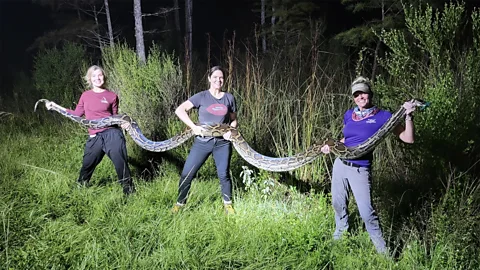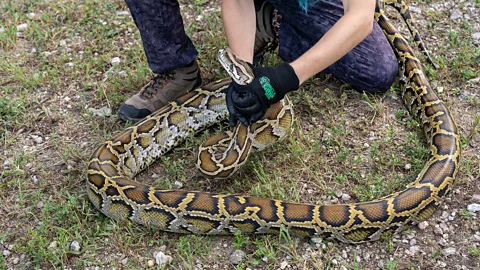Florida is paying bounty hunters to control its python population
 Amy Siewe
Amy SieweWhen invasive snakes began killing the Everglades' native wildlife, Florida came up with a plan: bring in bounty hunters.
Amy Siewe – or the python huntress as she's also known – is scanning the roads and grassy verges of South Florida. She's after a legendary 20 footer – a 6m-long invasive Burmese python, slithering through the grass in search of prey to strangle and consume. "You never know when that girl is gonna be coming across the road, so you wanna be there for it," she says.
In the winter, Siewe hunts invasive pythons by day. But in the humid, sweltering South Florida summer, she hunts by night, crouched in the back of her huge truck, goggles on to protect against bugs, eyes keenly trained to the roadsides, hoping to catch a tell-tale flash of scales slithering across the road, from woods to the canals. For Siewe, the dangerous job is not just about the thrill of the chase. It's also about saving a whole ecosystem.
Burmese pythons are thought to have come to Florida as pets in the mid-1990s. From 1996 to 2006, around 99,000 pythons were brought to the US to be sold as pets. When some escaped into the wild, they found a python paradise rich in prey such as mice, squirrels and birds – but also, large animals including deer and even alligators. The pythons are thought to hunt by using their sense of smell to identify trails left by their prey, then hiding nearby to ambush them, squeeze them to death, and swallow them whole.
Siewe can be travelling at 45mph (72 km/h) and spot one. "They spend 85% of their time not moving, and if they go back into the brush it's impossible to find them because they camouflage so well. So you can't hesitate." When she spots one, Siewe leaps off the truck, and jumps on the snake, grabbing it behind the head.
The hunters work in pairs, and so Siewe's sidekick will tape the snake's mouth shut. Big pythons, like the kind Siewe catches, have large, sharp teeth that can cause deep lacerations – although they are non-venomous. Despite the danger, Siewe is ionate about her work: "I know every single snake I catch is making a difference."
The bounty hunters
For four years, Siewe worked as a python removal agent for South Florida's Water Management District. She'd be paid by the hour – between $13 (£10.22) and $18 (£14.15) depending on where she was out hunting, for up to 10 hours – and a bounty for every python she caught. Fifty dollars for every python under 4ft (1.2m). Another $25 (£19.65) per foot. And a $200 (£157.19) bonus for finding an active python nest.
 South Florida Water Management District
South Florida Water Management DistrictAs the pythons are a regulated species, they cannot be transported alive. Florida's python agents are trained to kill the reptiles using a bolt gun. The programme, which was launched in 2017, has captured and euthanised 7,330 pythons so far. The majority were under 4ft (1.2m) in length, although 17 were captured that measured between 16ft (4.8m) and 17ft (5.2m) long.
On the side, Siewe would make extra money by skinning the python to make snakeskin accessories – a gruesome, messy endeavour. She eventually discovered she could earn far more taking tourists out on python hunting trips. And so she went solo.
Siewe's career may seem an unusual choice, but she's one of a handful of people making a living off hunting invasive pythons in Florida.
Destroying an ecosystem
The Burmese python is believed to have been introduced to Florida's Everglades through the exotic wildlife trade; they were once sought-after pets. The giant constrictors, which in Florida, have been found growing up to 18ft (5.5m), have thrived in the Everglades ecosystem. They have an insatiable appetite, and there is plenty of prey.
"They have devastated our ecosystem," says Mike Kirkland, senior invasive animal biologist at South Florida's water management district, who masterminded the python removal programme.
 Water Management District
Water Management DistrictKirkland says there has been a 90-95% reduction in furbearing animals in the Everglades National Park since the pythons appeared in the late 1990s. One study found a 99% decrease in racoons, 99% decrease in opossums and a complete absence of rabbits.
"Twenty years ago, the place would have been teeming with wildlife. Now I challenge you to find a single deer, possum, or squirrel. They have decimated our native wildlife," says Kirkland.
Kirkland refers to a now-infamous video recorded in South Florida's Big Cypress National Preserve in 2017 showing a python holding an alligator underwater until it suffocated.
A radical approach
At the time of its inception, Kirkland's programme was a radical approach to the complex question of how to eradicate invasive species. Python hunters – "spirited individuals", as Kirkland describes them – were granted unprecedented access to water management district lands. It was supposed to be a three-month pilot programme, and Kirkland didn't expect it to get much traction. The programme is now in its eighth year and has doubled its employees.
There are currently 50 paid contractors working for the agency, covering nine counties – which include state, federal and county lands. Donna Kalil is one of the "original 25" contractors who were hired by the water management district in 2017. To date Kalil has caught more than 850 pythons.
"Because they're an invasive species they continue to move and change their environment," Kalil explains. "And you have to continue to learn, to figure out their modus operandi. Every location is different, every environment they're in is different. It's like playing chess."
Since launching the programme, the agency has removed 8,565 pythons across the state.
 Amy Siewe
Amy SieweBut hunting pythons won't be enough, says Kirkland. He says it will take a multifaceted approach to rid the ecosystem of the invasive species – through education, policy, and innovative science.
